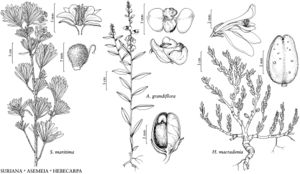Asemeia grandiflora
Man. S.E. Fl., 766. 1933.
Herbs (0.8–)2–5.5(–10) dm. Stems glabrous or hairs appressed or spreading. Leaves: petiole 1–4 mm; blade oblanceolate, linear-oblanceolate, elliptic, lanceolate, narrowly ovate, or linear, (6–)15–50(–64) × (0.3–)2–17 mm, base acute, apex acute, surfaces usually pubescent, at least on veins abaxially. Racemes usually loose, rarely very open, 5–10(–20) × 1–2.5 cm; peduncle 0.3–1.7 cm; bracts ovate to lanceolate. Pedicels (1–)2–4 mm, usually pubescent, sometimes glabrous. Flowers: sepals (1–)1.3–3.1 mm; wings orbiculate to reniform or obovate, often somewhat 4-angled, 2–6.8 mm wide; keel 2–5(–7) mm. Capsules ellipsoid, oblong, or ovoid, 3–5.3 × 2–3 mm. Seeds 1.1–2.5 mm; aril 1 mm, lobes helmetlike, to 1/4 length of seed. 2n = 28.
Phenology: Flowering spring–summer (year-round).
Habitat: Open dry, sandy habitats, open pine and oak associations, dunes, roadsides, savannas, prairies.
Elevation: 0–300 m.
Distribution
Ala., Fla., Ga., La., Miss., N.C., S.C., Mexico (Chiapas), West Indies, Central America.
Discussion
Asemeia grandiflora is highly polymorphic, with numerous historically recognized segregate species or infraspecific taxa (C. E. Nauman 1981b; J. K. Small 1933). However, the characters artificially selected for differentiating the taxa, such as pubescence, presence of glandular trichomes, relative length of capsules and wing sepals, wing sepal coloration and shape, capsule shape, keel length, and leaf width, are polymorphic features without consistent geographical structure. Other features, such as being more strongly perennial (multi-branched and suffrutescent) farther south and more clearly herbaceous or, perhaps, even annual farther north, are clearly correlated with climate and not necessarily indicative of taxonomic distinctiveness. This situation is further complicated by the species being part of the even more widespread complex of Asemeia violacea (Aublet) J. F. B. Pastore & J. R. Abbott as circumscribed by M. C. M. Marques. More work is needed to determine whether A. grandiflora should be treated as conspecific with A. violacea, as many other related entities are still recognized and no phylogenetic or populational data have been presented to show that this entity is unworthy of recognition.
Asemeia grandiflora is the only species of Polygalaceae in eastern North America with an entire keel (lacks a beak or crest).
Selected References
None.
